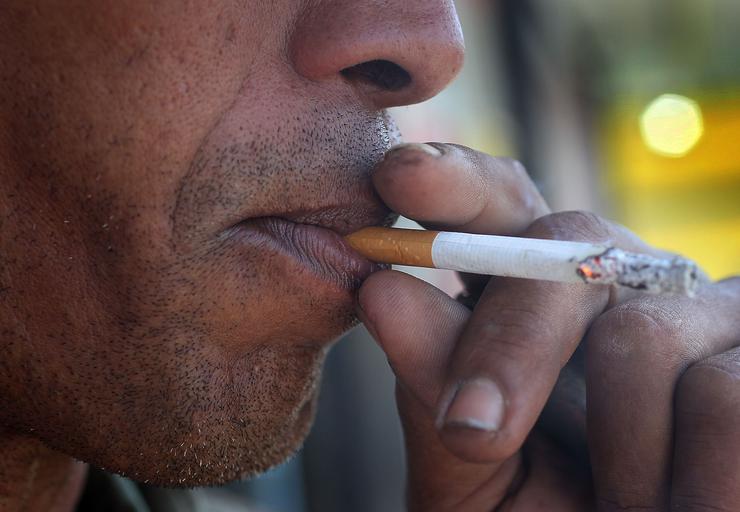I’m in the back of my parents’ red Ford Monarch. The sky is clear, and the night air is still too warm for a jacket. My father is driving, and the smoke from his Kool Mild hits me like an anvil. I’m seatbelt-less. The window is halfway down. It looks like the moon is chasing our car.
This was back in the ’80s, when Bill Cosby was a god; back when cars were made like tanks, and everyone had a telephone in their home. Back when cable was only a few channels, and a smoker could smoke anywhere: in the office, restaurants, and if you were nice with it, even on a public bus. I’ve seen it.
We were wild back then; no one cared back then. Everyone appears to care now ― about Black lungs, about Black health.
The government is planning to ban menthol cigarettes, and it feels racist-y.
Let me explain.
In 1925, Lloyd “Spud” Hughes wasn’t feeling so hot. He was an avid smoker, but he’d picked up a cold somewhere. One night he put his smoking tobacco next to his menthol crystals, and the next day menthol cigarettes were born.
Before this, cigarettes had tasted like trash. But for some reason, white men and some white women still smoked them. It was a luxury item for rich folks (remember those long black cigarette holders from all of those black-and-white movies? Looking at you, “Breakfast at Tiffany’s”), and as such, Black folks didn’t partake. Eventually, though, cigarette makers realized something: Because they didn’t target African Americans, Black people weren’t smoking cigarettes.
So that all changed. In the 1970s and ’80s, the makers of Kools began sponsoring jazz festivals, and their advertisements started featuring dimly lit images of a saxophone player. Even the spelling of “Kool” with a “K” was used to target Black people, since that was hip talk at the time. Kool and Newports changed their marketing campaigns to aggressively target Black folks in the two most prominent African American publications, Ebony and Jet, which reached a third of the adult Black population. Almost a third of the ads in both magazines were for cigarettes.
And it worked: Blacks became the largest users of menthol cigarettes.
In 1964, after researching some 7,000 articles, Surgeon General Luther Terry concluded that cigarette smoking led to lung cancer and heart disease. Surely, this would be enough to take the product off the market? Nope. Despite Terry’s insistence that the government do something about cigarettes, they just kept on allowing them to be sold. Oh, wait, that isn’t entirely true. They did issue a warning that appeared on the side of the packaging, acknowledging that cigarette smoking is dangerous for your health ― but they didn’t do it until 1969, some five years after Terry’s findings. That language would be changed in 1984 after Congress enacted the Comprehensive Smoking Education Act of 1984, which required that all cigarette packaging and advertisements carry the following message: “SURGEON GENERAL’S WARNING: Smoking Causes Lung Cancer, Heart Disease, Emphysema, and May Complicate Pregnancy.”
This brings us to the Heckler report. Before 1985, no one really cared about health disparities based on race. Well, maybe they cared, but no one kept track of it until 1985, when U.S. Health and Human Services Secretary Margaret Heckler released the Report of the Secretary’s Task Force on Black & Minority Health, marking the first time the U.S. government looked at whether race played a part in health care.
One of the report’s most shocking findings was that some 60,000 excess deaths occurred in the U.S. each year due to health disparities. This was about as close as America had come to admitting that racism exists in medical care. It was the first time race and health care converged on a national stage. Inside the voluminous report, there was a finding that Blacks suffered more than their white counterparts from high blood pressure and cardiovascular disease.
If America could do a study of this scope in 1985 (the task force was created in 1984, and the report was released the following year), surely they could’ve taken a look at the effects that menthol cigarettes had on Black people, especially since it had long been rumored that menthol made cigarettes easier to smoke and harder to quit. But that study wouldn’t be done until 1998. And the 1998 Surgeon General’s report “Tobacco Use Among U.S. Racial/Ethnic Minority Groups” found one minor caveat that no one seemed to care about then.
“Black smokers smoke less but die of heart attacks, strokes and other causes linked to tobacco use at higher rates than white smokers do, according to the Centers for Disease Control and Prevention,” a New York Times article noted last year. “And 85 percent of Black smokers use Newport, Kool and other menthol brands that are easier to become addicted to and harder to quit than plain tobacco.”
This means Black smokers were more likely to smoke menthol cigarettes and, as such, were more likely to die. America knew this in 1998. Want to know how long ago that was? Today, a child who was born in 1998 can drive a car, go to war and legally purchase and smoke menthol cigarettes. So we know, at the very least, that America was aware of the dangers of smoking menthol cigarettes some 24 years ago, and did nothing to stop it.
But before we look at why the ban to stop menthol cigarettes from ravishing the Black community is suddenly happening now, let’s look at the effects that menthol had on the industry. Adding menthol to tobacco lessened the harsh taste and made cigarettes easier to smoke. So why not create all kinds of flavors to entice new smokers? Well, in recent years, that’s precisely what flavored e-cigarettes did, with great new tastes like Gummy Bear, Funnel Cake, Fruit Punch, Berry Crunch Cereal and Blueberry Lemonade. Surely that lasted for some time, considering how long menthol was on the market?
Nope. Shortly after those flavors hit the market, the U.S. Food and Drug Administration banned them.
“Flavors attract them. Nicotine addicts them,” Matthew Myers, president of the Campaign for Tobacco-Free Kids, said late last year. “Without the flavors, many fewer kids would be attracted to these products — 85% of the kids who use an e-cigarette use a flavored one.”
But it wasn’t just the assortment of flavors. It was menthol.
“Flavors are a top reason why young people begin using e-cigarettes,” an April 22 report by Truth Initiative reads. “Research shows that mint and menthol e-cigarette use among high school users rose from 16% in 2016 to 57.3% in 2019. Among high school JUUL users, 67.5% reported that their preferred flavor was mint or menthol. Another study, conducted before JUUL pulled its other flavors from the market, found that mint was one of the most popular flavors among high school student JUUL users, but that menthol was less so.”
“Study authors caution that leaving mint and menthol flavors on the market undermines the purpose of removing flavors — which is to prevent kids from using e-cigarettes at all,” the report notes.
White males are the most likely to use e-cigarettes.
See where I’m going here? No need to belabor the point.
I don’t have a memory of my father that isn’t clouded in smoke from a Kool Mild. He never stopped smoking. Not after two heart attacks, not after he stopped eating. My last memory of my father is from around my birthday. I’d taken my kids to see him. He was frail and could barely hold himself upright. He shuffled to walk my family out of the house, and waved as we pulled off. I could see in my rearview mirror that he was lighting a cigarette.
The ban on menthol cigarettes is long overdue, but America knows that. Black lives have always been a byproduct of white life, our safety a spinoff. It’s the impetus of the Black Lives Matter movement ― you know, the part that always gets left out, implicitly saying, “Don’t I matter, too?”

